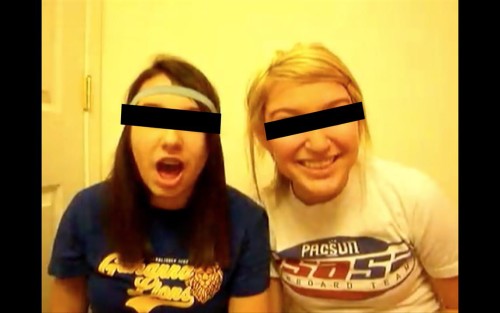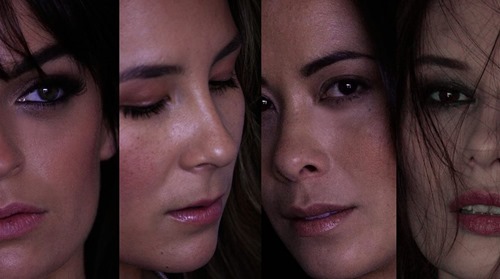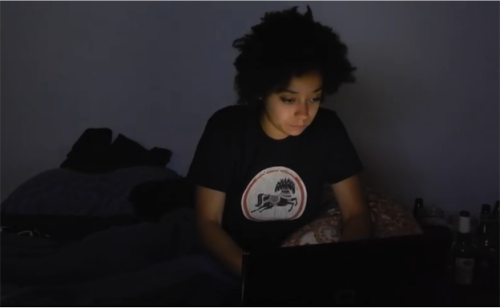Breaking Dawn, Part 1 opened in theaters last Friday, November 18th. I mainly know this because my sister, a self-professed “Twi-Hard” talked about it nonstop for about two weeks. She also went to the midnight showing. I’ve seen all the previous films in the series and wrote about
New Moon awhile ago, and I’m well aware of the feminist criticism of both the novels and the films. I personally find the films fairly nuanced (don’t judge), and I think they invite many different, more complex readings than they’re often given. However, I’d say the series is pretty antifeminist overall. I suppose I’m most bothered by the disgusting, misogynist reaction to the
fans of the Twilight Saga (who are mostly young women), and the disgusting, misogynist (and homophobic) reaction to Edward as a sparkly (read: totally, like, gay dude) vampire–as opposed to a super awesome killer vampire who, you know,
doesn’t sparkle. And it isn’t surprising that it’s mostly young dudes who lambast girls and women all over the net for loving
Twilight, yet it’s perfectly acceptable for them to male bond over the horrible franchise that is
Transformers (and to simultaneously ogle Megan Fox’s ass, of course). This is all for another post about The Rise of the Fangirl, though, which I
will write one day. At the very least, it’s important to discuss
Twilight because it’s the First Franchise Film Series Ever to directly target teen girls, and we should probably look at what that means for the future of films made for young women, especially since the
Twilight Saga has been overwhelmingly successful at the box office. Luckily, I found an amazing interview with Dr. Natalie Wilson, who points out some major problems with the Twilight Saga, and who blogs for one of my favorite sites,
Professor, What If …?
This post is dedicated to my sister, Heather, who needs to understand that the Twilight Saga is kind of bullshit. I included a transcript in case the video doesn’t play. Enjoy!
Dr. Jenn: This year for Halloween, we’re going to discuss a pop culture phenomenon about vampires: the Twilight Saga. And I actually personally don’t know a lot about Twilight, but we have a local San Diego professor who knows a ton about this–and specifically a lot about bringing a feminist perspective to analyzing this book and movie series. Today we have Natalie Wilson, who’s a professor of Women’s Studies and Literature at Cal State, San Marcos, specializing in pop culture, feminism … and has a particular interest in sexuality, monstrosity, and the body. She blogs for Ms., Girl With Pen, and Womanist Musings, as well as her own blog, and had two books that came out this year: Seduced by Twilight and Theorizing Twilight. Good to have you on the show. So I know that you do a lot of teaching, writing, and research around women’s equality, and that you tie it to a study of popular culture. How do you do that?
Dr. Wilson: Right. Well, I think oftentimes popular culture is written of as just entertainment, as if it doesn’t matter. But actually popular culture is sort of a huge barometer of what’s going on in our society. So I like to think of studying popular culture as sort of taking the pulse of society. And when you look at popular culture, you can tell how healthy or unhealthy some of our views are. And as a women’s studies professor I’m particularly interested in gender and sexuality, and that is what sort of spurred my interest in writing about the Twilight Saga, because it’s a huge cultural phenomenon, and I feel like it sends some rather problematic messages about gender and sexuality.
Dr. Jenn: And I know you’ve even taught a class about this, a college semester long class about it. Okay, so what would you say the Twilight Saga says about gender, women’s sexuality, and sexual health?
Dr. Wilson: Right. Well, in terms of gender, I would say it’s rather regressive, very traditional roles of gender. For females, you’re supposed to first fall in love, then you’re supposed to get married—no sex before marriage—and as soon as you get married, you should have a child. And you should also give up college because you know, you can’t go to college and be a mother; that would be impossible. So, very sort of regressive ideas in terms of femininity and the female role, really marriage and motherhood. And then in terms of masculinity, the males that are held up in the series as the desirable males are very controlling, almost hypermasculine, very strong, very muscular, very domineering, and very possessive and controlling and even violent toward the females in the series.
Dr. Jenn: And that’s what I was going to ask. I know there seems to be a connection between violence and sexuality, so what have you found around that?
Dr. Wilson: In terms of sexuality, the series is often called “abstinence porn.” It kind of drips with sex, but no sex ever really happens, so there’s desire around sex, but you’re not supposed to have sex before marriage, so there’s a definite abstinence message. And in particular, the female of the series, Bella, is held up as the one that’s responsible for not getting the males too excited, and she’s sort of the policer of chastity.
Dr. Jenn: So the responsibility is put on her.
Dr. Wilson: Yes, the responsibility is put on her. The other thing is that there’s this equation with sex and death—because she’s attracted to a vampire and a werewolf, both of who are supernaturally strong, and could kill her very easily. So the idea is if you turn them on, or you get too involved, your life is at risk. So there’s this equation with sex equaling death for females.
Dr. Jenn: Yikes. What about in terms of, like, the importance of how these messages are showing up … because I know if you look at our rates of STDs and pregnancy compared to other countries, there’s a big difference. Can you speak to that?
Dr. Wilson: Yeah. I think one of the things that happens with sexuality in the novel is there’s lots of desire, but there’s no serious conversations around sex. And there’s, you know, “you will be damned if you have sex” or “you will die,” but there’s nothing about contraception or sexual health or what a healthy relationship is; in fact, Edward is quite abusive. On their first night, their first honeymoon night, Bella ends up black and blue the morning after because he’s so strong, and he’s holding onto her so tightly. And this is framed as very hot and exciting rather than as some sort of sexual violence.
Dr. Jenn: And didn’t one of them black out … is that right? … Or didn’t have memories of that?
Dr. Wilson: Right. She wakes up, and she’s in this post-coital euphoria; meanwhile, she’s completely black and blue and supposedly doesn’t realize that she’s black and blue until she looks in the mirror. And then when she looks in the mirror, she calls the bruises decorations, and that they are, you know, him decorating her with his love. So this sort of blurring of sexuality and violence and sex being dangerous … and then what you were saying about STIs and teen pregnancies: it is a series that’s hugely popular with teens and young people, and there’s no emphasis on, you know, that these types of violent relationships are unhealthy. In fact, they’re held up as desirable. There’s never a discussion of contraception. And she does end up pregnant, of course, the night of the honeymoon.
Dr. Jenn: Her first time?
Dr. Wilson: Yeah, her first time. And then that is framed as, you know, the happy ending. Like, the marriage and her becoming a mother are framed as the happy ending.
Dr. Jenn: You’ve said a lot already that’s very impactful. Anything else that you can speak to … what you think … how this impacts the teenagers that are fans of this?
Dr. Wilson: I think an important thing to point out is that it’s had a huge cross-generational impact, so even though teens are a huge part of the fandom, it’s also very popular among twenty and thirty year olds. And there’s the Twilight moms, so it’s really had a pretty big cultural impact. One of the things you might’ve heard of is the tendency to have a team, like, you’re Team Edward or you’re Team Jacob. And that has sort of spilled out into other … I mean, vampire shows, but also other shows as well–like True Blood, there’s Team Eric or Team Bill. And if you notice, all the teams are male. So it’s this very old idea of male as the sexual aggressor; they’re the one who’s in competition for women—very hypermasculine—and then women are held up as, you know, they can be the fans, or they’re literally sort of the objects that the men are fighting over. So it seems to me in terms of it spreading out into popular culture, it’s going backwards and sort of regressing to older ideas about sexuality where the male was supposed to be the aggressor and the female was supposed to be the passive, you know … And of course, very heteronormative, and very … married, monogamous sex is the only type that’s allowed. And there’s this sort of hypermasculine … the bodies of the males in the films as well as in the books–super muscular, super strong. So those are bodies that are often associated with being violent, and in the saga, they are violent; but it’s held up as, “he just couldn’t help himself,” either he was so turned on that he couldn’t help hurting me, or he loves me so much that he became violent and became jealous. And with the rates of, you mentioned, STIs and teen pregnancy, the United States also has the highest rates of teen sexual violence. So it’s kind of saying that teen sexual violence, “it’s just because he loves me so much” or that it’s actually romantic rather than problematic.
Dr. Jenn: Oh my gosh. Thank you. That was a ton of information. Give a hand here for Natalie Wilson. Wow. And if you want to find Natalie online, you can visit Seduced by Twilight.



















